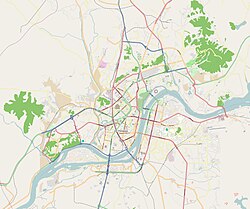Chilgol Church
| Chilgol Church | |
|---|---|
 Entrance of Chilgol Church | |
| 39°01′55″N 125°40′31″E / 39.031907°N 125.675257°E | |
| Location | Kwangbok Street, Chilgol, Kwangbok, Pyongyang |
| Country | North Korea |
| Denomination | Protestant |
| History | |
| Founded | 1899 |
| Dedication | Kang Pan-sok |
| Architecture | |
| Years built | 1989 (rebuilt) |
| Administration | |
| Division | Korean Christian Federation |
| Chilgol Church | |
| Chosŏn'gŭl | 칠골교회 |
|---|---|
| Hancha | 칠골敎會 |
| Revised Romanization | Chilgol gyohoe |
| McCune–Reischauer | Ch'ilgol kyohoe |
Chilgol Church (Korean: 칠골교회; MR: Ch'ilgol kyohoe) is a Protestant church on Kwangbok Street, Kwangbok, Chilgol, Pyongyang, North Korea. It is one of two Protestant churches in the country.[1][2] It is dedicated to Kang Pan-sok, who was a Presbyterian deaconess and the mother of Kim Il Sung.[3]
History
[edit]The church was founded in 1899.[1] It was attended by Kang Pan-sok, the mother of Kim Il Sung who sometimes accompanied her there.[4]
According to North Korea, the church was destroyed in June 1950 in the beginning of the Korean War by an American bombing[1] and Kim Il Sung ordered that the church be rebuilt on the spot where the original one associated with his mother had stood.[5] The church was rebuilt in its original style in 1989,[6] and placed under the authority of the Korean Christian Federation.[7]
There is a museum devoted to Kang near the church.[8]
Worship
[edit]The church welcomes believers on official visits, foreign travellers to Pyongyang, diplomats, and members of international organizations. Morale, patriotism and national unity are celebrated there and prayers are made for the reunification of the country.[1]
The congregation is exactly 201 persons.[9] North Korean defectors from outside Pyongyang have reported that they were not aware of the existence of the church.[3] The church is under lay leadership.[10] Protestant pastors are present in the church, but it is not known if they are resident or visiting pastors.[3]
The church is characterized as Protestant, but a denomination is not specified.[11]
Politics
[edit]South Korean missionaries consider the church to be an instrument of state propaganda.[12] South Korean pastor Han Sang-ryeol visited the church on 28 June 2010.[13] His travel to North Korea was not authorized by the government of his home country and he was sentenced to five years in prison upon his return to South Korea.[14]
See also
[edit]References
[edit]- ^ a b c d "Eglise de Chilgol" [Chilgol Church] (PDF). La République populaire démocratique de Corée (in French). North Korea: 36. November 2012. Archived (PDF) from the original on 3 March 2016. Retrieved 17 April 2022.
- ^ Corfield 2014, p. 27.
- ^ a b c "International Religious Freedom Report for 2014 : Korea, Democratic People's Republic of". U.S. Department of State. Archived from the original on 26 March 2021. Retrieved 3 December 2015.
- ^ Justin Corfield (1 December 2014). Historical Dictionary of Pyongyang. Anthem Press. p. 37. ISBN 978-1-78308-341-1. Archived from the original on 16 February 2017. Retrieved 10 October 2016.
- ^ Morse Tan (24 April 2015). North Korea, International Law and the Dual Crises: Narrative and Constructive Engagement. Taylor & Francis. p. 67. ISBN 978-1-134-12250-9.
- ^ Yonhap News Agency, Seoul (27 December 2002). North Korea Handbook. M.E. Sharpe. p. 449. ISBN 978-0-7656-3523-5.
- ^ Kim Yu-gyong (25 August 2009). "Office de dimanche" [Sunday service] (in French). Corée d'aujourd'hui. Archived from the original on 30 December 2021. Retrieved 17 April 2022.
- ^ Pearson, James (12 August 2014). "In North Korea, a church renovated, missionaries jailed". Reuters. Archived from the original on 9 December 2015. Retrieved 3 December 2015.
- ^ Do Kyung-ok; Kim Soo-Am; Han Dong-ho; Lee Keum-Soon; Hong Min (24 September 2015). White Paper on Human Rights in North Korea 2015. Korea Institute for National Unification(South Korea). p. 222. ISBN 978-89-8479-802-1.
- ^ United States. Dept. of State (2008). Annual Report, International Religious Freedom: Report Submitted to the Committee on International Relations, U.S. House of Representatives and the Committee on Foreign Relations, United States Senate by the Department of State, in Accordance with Section 102 of the International Religious Freedom Act of 1998. U.S. Government Printing Office. p. 178.
- ^ Foster-Carter, Adrian (23 December 2000). "Pyongyang Watch: Some of that old-time religion". Asia Times Online. Archived from the original on 9 June 2001. Retrieved 31 January 2016.
{{cite web}}: CS1 maint: unfit URL (link) - ^ Kim Hyung-jin (18 May 2007). "Does genuine religious freedom exist in communist North Korea?". Yonhap News Agency. Archived from the original on 29 January 2016. Retrieved 3 December 2015.
- ^ "Photo : Le pasteur sud-coréen Han Sang-ryeol prie dans une église nord-coréenne" [Photo: the South Korean pastor Han Sang-ryeol prays in a North Korean church] (in French). Yonhap News Agency. 28 June 2010. Archived from the original on 3 July 2013.
- ^ "Un pasteur condamné à 5 ans de prison pour visite illégale en Corée du Nord" [Pastor sentenced to five years in prison for illegal visit in North Korea] (in French). Yonhap News Agency. 21 January 2011. Archived from the original on 29 January 2016. Retrieved 3 December 2015.
Works cited
[edit]Corfield, Justin (2014). "Chilgol Revolutionary Site". Historical Dictionary of Pyongyang. London: Anthem Press. pp. 27–29. ISBN 978-1-78308-341-1.
External links
[edit] Media related to Chilgol Church at Wikimedia Commons
Media related to Chilgol Church at Wikimedia Commons

